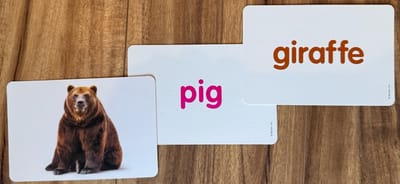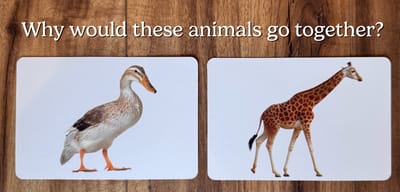
My kid and I had a fun time with some Animal flashcards. I thought it was worth writing up.
Now, they’re supposed to be mere reading practice, but my kid can already read the animal names. In a typical situation, he’d be sent off to the corner as the dreaded “early finisher.” The goal is just too low.
But here are three ways we transformed these low-level flashcards into tasks that maintained my high-energy kid’s interest.
1. Make Groups
Now, my first thought was to use a Hilda Taba-style Concept Formation task.
- First make a few pairs out of the animals using any criteria you’d like: furry, four legs, has antenna, lives in swamp, whatever.
- Then, start adding to the pairs, making groups of three, four, etc.
- Eventually all of the animals get sorted into 3 – 5 categories.
I use Concept Formation all of the time from class mottos to character archetypes.
However, my kid is stubborn. He resisted the idea of making larger groups and liked to just make pairs. Oh well. In a classroom, this always worked better!
2. Partners
So, my kid rebelled against my initial plan. He only wanted to form pairs. “Oh, okay. Let’s do it!” I was eager to see what he’d come up with.
Make groups of two using this pile of animals. Use any reason you’d like. But try to surprise me!
He ended up with these pairs:
- Turtle and Lizard — because they’re green.
- Ant and Bee — because they have black eyes
- Giraffe and Lion — because they are both found on the savannah
- butterfly and owl — they both have wings
- lady bug and pig — they’re both “have a reputation for cuteness”
- cat and goat — they’re my favorite mobs in Minecraft
Here’s the beauty: do this with 10 students and they’ll all come up with different pairs for different reasons. The variety of criteria will astonish you. Everything from the bland “both are green” to the hilarious “reputation for cuteness” and the highly personal “my favorite mobs in Minecraft.”
So then, after letting my kid form a bunch of pairs, I switched tactics.
3. A Forced Pair

Next, I picked two animals that I thought had no obvious similarities: the duck and the giraffe. “Why would these be partners?” I asked.
He cocked his head. “They both have long noses.”
Noses! Not necks. Amazing.
Again, ask a dozen students and you’ll find all sorts of interesting reasons for why two random animals could be partnered together.
In fact, you might press ahead and ask, “Give me three reasons why I’d group these two animals together.”
Or ask for specific reasoning. (I call this sharpening my questions.)
- Give me the least interesting reason we’d group these animals.
- What’s the weirdest reason we’d group these two?
- Why would an evil scientist group these two animals as partners?
Anyway. That’s a few ways that I’d upgrade a pack of low-level flashcards and get students really thinking.
Related Videos For Byrdseed.TV Members


